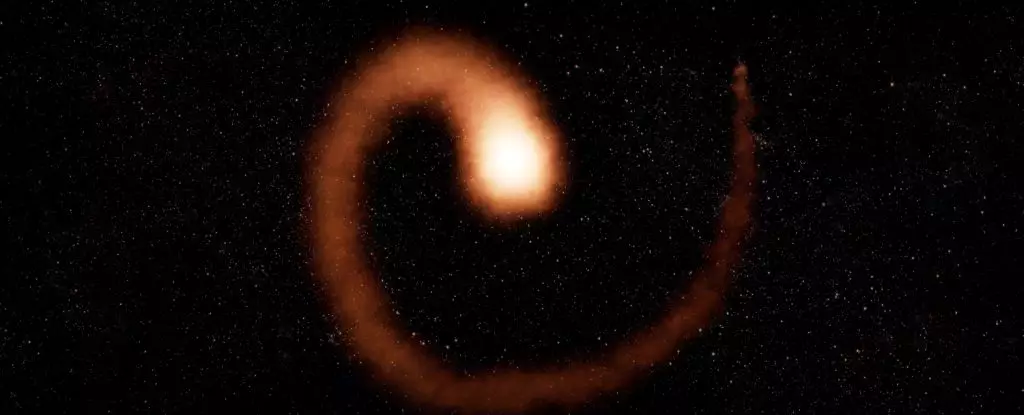Deep in the cosmic expanse, light-years away from the familiar blue planet we call home, two stars engage in a spectacular celestial waltz that has piqued the interest of astronomers and astronomy enthusiasts alike. This dynamic duo is part of the Wolf-Rayet 104 (WR 104) system, a binary star arrangement that is on the cusp of a magnificent, explosive death. Often referred to as the Pinwheel Nebula due to its mesmerizing spiral shape, this stellar system illustrates nature’s ability to captivate us with its beauty, even as it approaches a violent end.
At the core of WR 104’s intrigue is its dual-star system, comprising a Wolf-Rayet star—a highly luminous and massive stellar titan nearing the end of its life—and a companion OB star. The interplay between these two massive entities not only carves out beautiful structures in the cosmos but also raises questions about cosmic events and their implications for Earth. The spiraling dust features, the remnants of stellar winds colliding in a symphony of energy, showcase the astral artistry we rarely get to witness up close.
The Spectral Spectacle: Life and Death of Massive Stars
Wolf-Rayet stars, such as the one at the heart of WR 104, are unique; they represent a stage in stellar evolution where they have shed a considerable amount of their mass, driven by intense radiation pressures. These stars typically live fast and die young, with WR 104 being a mere 7 million years old. In astronomical terms, this is a blink of an eye. The sheer luminosity and rapid loss of material through stellar winds mean that when these stars finally do die, their explosions are nothing short of extraordinary.
The presence of a binary companion amplifies the spectacle, as the gravitational tug-of-war between the stars influences the shapes and paths of ejected materials. As dust from the Wolf-Rayet star spirals out into the cosmos, the OB star’s powerful winds collide with it, creating intricate structures that are beautifully recorded in infrared imagery. The resonance between these two stellar giants serves as a chronicler of cosmic evolution—the dynamic processes that shape not just their fates but potentially the fate of surrounding celestial bodies.
A Cosmic Sigh of Relief: Navigating Potential Catastrophes
One of the most pressing concerns regarding Wolf-Rayet stars has been their potential to unleash catastrophic gamma-ray bursts, particularly if their poles are directed towards Earth. Previous hypotheses positioned WR 104 in a perilous alignment, potentially putting our planet at risk should it explode in a supernova. Thankfully, recent observations have revealed that the stars’ orbital plane is tilted—preventing the dangerous radiation from aiming straight at us.
The work of astronomer Grant Hill, alongside his colleagues from the Keck Observatory, has led to this newfound understanding of the system’s orientation. It’s an exciting revelation that allows humanity to breathe a collective sigh of relief, at least for the next several hundred thousand years before the anticipated supernova might occur.
Cosmic Puzzles: The Unexpected Misalignment
Despite offering relief, the research also gives rise to new questions. The misalignment between the spiral dust pattern and the stars’ orbital plane challenges existing theories of stellar behavior. How can it be that the dust appears oriented towards Earth while the poles remain safely pointed away? Such apparitions exemplify the unpredictability embedded within the universe.
Science often demands that we reconcile our models with the anomalous data that emerges. WR 104 serves as a prime example of how exploration leads to unforeseen complexities. Each cosmic observation encumbers us with the dual responsibility of understanding what we see and grappling with the mysteries that remain concealed just beyond our current knowledge.
The Allure of Discovery in Astronomy
The ever-unfolding story of WR 104 embodies the essence of astronomical inquiry—a journey into the vast unknown. It encapsulates both the wondrous and often bewildering realities of the universe. As humanity crafts sophisticated tools to peer deep into the cosmos, we continually encounter cosmic wonders that confound our understanding. This spiral of discovery is what fuels our curiosity and inspires future generations to delve into the complexities of the universe.
As we look to the stars, WR 104 reminds us that while we may uncover urgent discoveries, we also willingly embrace the uncertainty and mystery that come with being a part of the broader cosmos. The beauty and terror of these celestial phenomena serve as a testament to our quest for knowledge and our limitations as mere observers in a grand, intricate universe.

